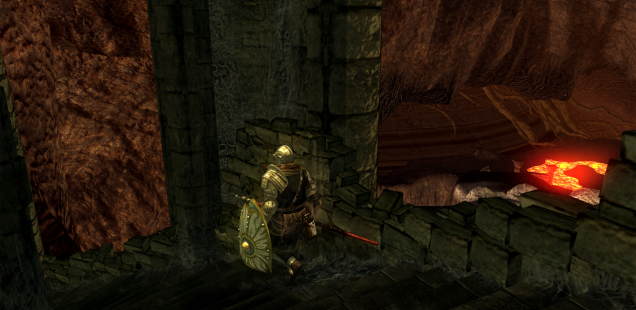
The Downward Climb
M Stenbæk plumbs the depths of Lordran.
Many folks have pointed out the world of Dark Souls resembles a map of the psyche, but little has been done to cartographize this terrain. If we begin with the basic premise that the hub world, Firelink Shrine, is the starting point of a psychological unfolding, then the next assumption is to see upward trajectory as aspirational and emancipating, and downward trajectory as reflective and inward. This latter leaden path is rarely the first one selected by the player, a little harder to find and more treacherous, but its symbology is quite rich. When the Crestfallen Knight of the Shrine mentions this direction, it’s with sardonic caution.
As in dreams, each successive layer of descent in Dark Souls indicates deeper and deeper domains of the psyche. The further down you go, the more fantastic the landscape becomes, and the more primal the mythological material. We shall look at these stages in terms of successive depth, but keep in mind that it is impossible to make progress in the game solely by going down. At certain points, one must take a break and reach upward for a while in order to plumb further down again. So this essay is structured geographically, rather than directly following gameplay trajectory – and while some of these stages can be skipped, they cannot be meaningfully reordered.
The expected path of descent begins in the township. The chosen undead opens a door and takes a long ladder down to the poorer part of town, where the houses are much smaller, and fires go unchecked. Thieves threaten to murder and rob anyone brave enough to walk through the derelict streets. This area is the “wrong side of the tracks,” where the undesirable things go: the criminals, the hungry, the desperate. As a psychic landscape, it is only partially unconscious. It still has order: houses, people, and a clear direction to follow. It lies in shade, indicating that it is on the threshold of escaping consciousness. The downward incline at this point is gradual, but clear. The people who live here are violent and not wholly integrated into the relatively civil upper undead burg, but are nevertheless part of the same city, acknowledged by the ego to be functioning psychic components.
The incline briefly plateaus in the chamber of the Capra Demon, who ambushes you in a tiny room with his rabid dogs. The player is cornered by relative realism – it as though they are trapped, ambushed, mugged – threatened by very “real” dangers. The discomfort and fear of navigating the psychological shadow is here at its most rational: projecting the fear of the Other onto real people in a community. The Capra Demon is a creature of Capricorn, which symbolizes the limitations of matter, and the business of the superego: obligation, societal order, infrastructure, systems which can empower or disenfranchise. Here is Dark Souls doing realism: a reasonable situation (turning a wrong corner in a bad neighborhood) is punished by a cruel and unfair encounter (dead end ambush with dogs). This battle is touted as a milestone in Dark Souls for its difficulty, and it is likewise a milestone in the psychological individuation process. Here you are confronted with the cold, hard facts: opportunist humans in a damaged and impoverished society. But you see that this is not the source of your suffering. And by overcoming the devil of external, organized materiality, you receive the key to the next challenge: the internal materiality, the personal body.
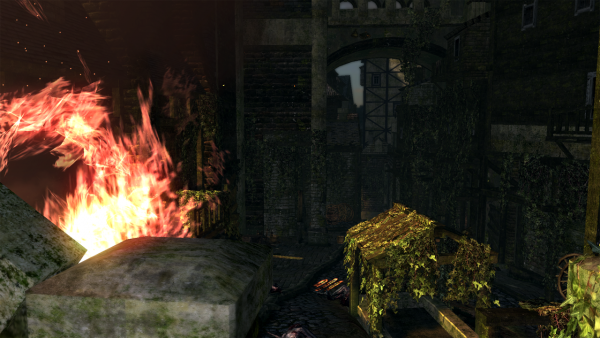
The digestive tract, the toilet, and the sewer are all classic dream symbols of the body – in particular, the aspects of the body that inspire disgust, revulsion, rejection. So we can see how the sewer is a more sophisticated and yet more blatant metaphor for repressed psychic contents. This is where Dark Souls begins its toilet humor. Remember: the Capra Demon represented a “breakthrough” moment. For the first time, the player goes underground, burrowing into a solid wall, and gets a sense of how huge is the house of unconscious material. This revelation has reframed the unconscious as an elaborate, dark maze – though it retains the tight passages of its previous form. The tight passages indicate, as above, the trepidation and constraint one feels when exploring this uncomfortable side of the psyche.
Here we have the animalistic scramble of hungry hollows as they await their supper from the mother-figure of the butcher, who intimidates with large castrating cleaver. Directly below the mess-hall there is a small thick pool (is it mud? waste? grease?), which we briefly trudge through in the tightest quarters yet. Thick beams support a low ceiling. Dogs outmatch your agility in the soup. This is perhaps the first time that a weapon with an overhead swing is useless. Claustrophobia and inertia emerge as a theme and a threat. On the other side of this small but intense pool, a genuinely optimistic native of the swamp is trapped, inert, in a barrel, and rescuing this fellow allows you to learn pyromancies. The main encounter with fire in the previous stage was a useless hazard; here, it becomes our ally, Laurentius. It is our first vague indication that the birth of fire lies somewhere at the bottom of this unconscious realm. We accept this pyromancer as our friend (we recognize the part of ourselves which is native to the swamp) and in doing so we are given our first opportunity to make use of fire, the animating force which created and consumed the world.
The sewer is obviously not in great condition: wads of slime and blocked passages suggest an ailing intestinal tract, or that the digestive role of the psyche is in disrepair, disrupting fluid communication to the more primal unconscious material which lurks below (symbolized by Izalith et al). If we hunt around we find the disturbing revelation of the preacher presiding over a throng of rats. Let’s take moving downward to be moving into the past, into that which is buried. So to find a holy man / father figure commanding a group of rats which he empowers against us, on a rampart overlooking the arena of confrontation… there are a number of ways to interpret this, and I leave you to your imagination.
The son (pyromancer) and father (trident) figures are minor scenes, skippable fragments of trauma in our memory-maze of abjection, but the mother recurs to us throughout. Julia Kristeva introduced the idea that the original object of abjection is the mother, because that’s the first form from which we differentiate ourselves. “We must abject the maternal, the object which has created us, in order to construct an identity.” This is a major keynote of this dungeon. In addition to the butcher, the image of the mother is given to us as a big mama rat, and by leaping creatures with frightening, boob-like heads. Literally they are “basilisks”, the sight of which immobilizes the player (but the frog is also an interesting comparison, as it is a classical symbol of Venus, feminine beauty – except here it has been corrupted).
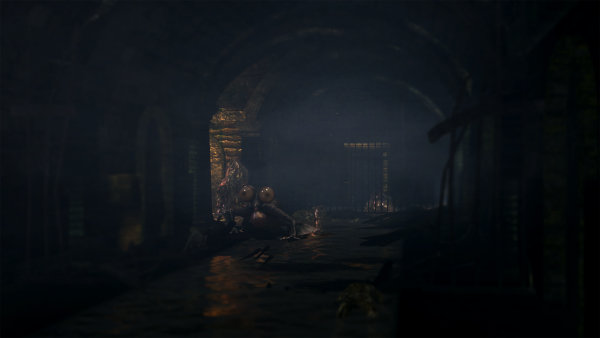
At bottom, we encounter the image of the mother rephrased as a malformed dragon. It is a great gaping and tooth-filled yoni. This is a particularly revolting and primal form: the “devouring mother” who threatens to overwhelm the player, consuming our being back into her body, into dormancy and total dependence, like Laurentius in his barrel.
As others have pointed out, this creature is a descendant of the everlasting dragons. Those dragons, who exist outside of time, symbolize the Mother in her highest conceivable state: the matrix of creation from which all phenomenal experience is derived. The image of a dragon represents a cardinal pattern within that matrix, currently unmanifest within the primary sphere of our experience. The Gaping Dragon, this distant descendant, has been corrupted within the psyche of the chosen undead by a poisonous relationship to the Mother. If the Capra gave us the keys to the body, we find that the body’s memory extends back to the point in which it was surrounded by the Mother. And here the Mother still lurks in a dank chamber, transformed by repression and lack of sunlight into a corrupted state – a one dimensional feeding machine. So, like many dragons of mythology, it must be slain so that the process of self-understanding can proceed. The key the dragon gives us brings us to the first wide-open unconscious arena.
Those who are not fortunate enough to live between the damp stone walls of a pestilent sewer must make their home below it: on rickety scaffolding above a valley of shit. Blighttown is the scourge of Dark Souls, its repugnance reaching a gameplay-disrupting level. Here, by a large leap, we reach a finer metaphor for the repressed psyche: the dark cave. We again retain the dimness of the above levels, and the constraint of passage, but now it is far more dangerous, situated upon a treacherous structure which could give way at any moment. The lattice of understanding we have built for this level of consciousness is pathetic. An undead dog runs in a hamster wheel to power a continuous elevator, in mockery of the inventions of the surface/ego. The ladders which further our descent are hard to see, but resting at this precipice is not possible due to the endless intrusion of bloodsucking mosquitoes.
The style of enemies have changed dramatically: rather than typical desperate and confused hollows, we have obstinate dart blowers and ogres. Already these beings have mutated through prolonged drought of humanity, but the situation gets worse as we go down. The infested ghouls are contaminated past the point of human, consumed by hunger, madness, rage, and soon we find horrendous semi-humanoid “cragspiders”, beings who are hopelessly malformed and animalistic in their behavior.

These creatures follow us to the very bottom of an enormous shit-valley, where at last the arena opens wide, and again we adjust our understanding of the repressed psyche to a more sophisticated and expansive scope. This is a moment where the attitude toward the repressed changes. No passages restrict our movement here, only the muckiness of the omnipresent poisonous waste, a metaphor for depression and torpor. In the distance we see an enormous spider nest, which summons conflicting feelings. It inspires fear and foreboding, but the idea of “nest” also suggests, for the first time, home. Things have gotten a bit brighter down here, and the white spider’s nest faintly glimmers almost like a castle in comparison to the sludgy wasteland. It is an indication of beauty and architecture buried in the abominations of the deep unintegrated psyche. We are reminded there is something here to retrieve.
Like any well-designed boss, Quelaag is philosophically emblematic of the environment. She is a grotesque sight: from the waist-up she is a naked woman, and from the waist down she is a gnarly, fiery spider. The mythological motif of a feminine being with the lower half of a beast is a common one (mermaids, deer-legged or chicken-legged demons). It describes a complex in the psyche which hasn’t fully formed into autonomous realization, but is partially “embedded” in the undifferentiated psychic environment. I’d prefer to ignore the fanservice intro to this battle, but it does reveal a few key things about the character: her relation to desire, and her incongruous placement in the general thematic palette of Dark Souls. In addition to the cutscene, it’s her general design — her character model, moveset, and item drops — that portray her as someone who has stepped out of some other, more sensational franchise.
She and her 6 sisters are something like multivalent capitulations of anima, the otherworldly spark of inspiration. Quelaag herself is the base corruption of artistic impulse into superficial thrills: a creature that is half hot girl, half horrible beast, and when u beat her u get a badass sword. The Fair Lady is the atrophied, unappreciated anima. She is an even more feeble archetype than Quelaag: she is the most helpless of all damsels, incapable of speaking in common, sickly and immobile, easily deceived and killed – she is at the mercy of the player, essentially. The only other sister with a name is Quelana, who is encountered before the spider’s den, inconspicuously resting against a wall in the filthy basin. This is the only sister who retains her sanity, and who becomes your ally, teaching you the most powerful flame sorceries in the game. Her spells are primordial, essential fire – long predating the invention of pyromancy, which is to say, before intellect and science sought to control this raw, libidinous power. She is difficult to see in the dark swamp, and won’t appear at all unless the player has reached an eminent level of mastery over fire.
The arson fire of lower undead burg marked our initiation into the downward climb, and became more important in each successive layer of subconscious darkness, and the flame took on more complex forms. The lad we rescued from the sewer represented indirect knowledge of fire, passed on through cultural traditions, and was our first integration of this animating power. This next plateau introduces us to the sisters, beings born from the flame, and if the player is able to engage with Quelana, they receive a higher integration: explicit tutelage from a master, from a daughter of fire.
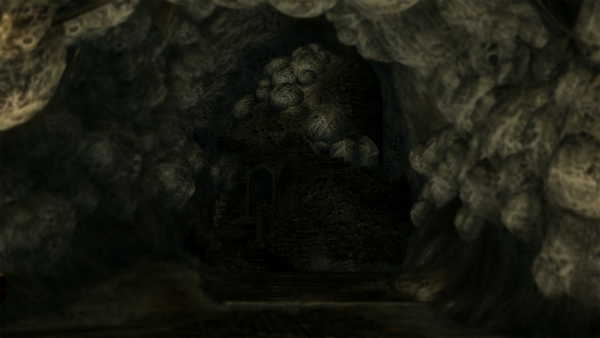
After Quelana and Quelaag, the brief womb of the spider nest, we are born again into yet another renovation of the unconscious: an expansive hellscape. There is no sign of human habitation down here: no more semi-conscious undead or ramshackle structures, only ruins, monsters and mountains. To formalize this new chthonic threshold, we are given our robes of initiation – or rather, we seize them from under the nose of a giant, mourning beast. The Ceaseless Discharge is the sole son of chaos, and we find him looming over the corpse of his unnamed sister, which bears the robes. When the player takes these robes, Ceaseless attacks in a rage.
Ceaseless is raw, untamed energy, hastily crammed into a form that spews excess and emotion. In the lore of the game, he was with born with wounds inflamed by lava, and his sisters gave him an enchanted ring that kept the lava from hurting him. He “foolishly” dropped the ring and it sprang into a centipede demon – though the game suggests that he lost his entire hand in this incident. The player can wait for Ceaseless to get his injured stub-hand stuck in the cliffside during the battle, and then knock him off the cliff in a few hits – this is the most well-known boss exploit in Dark Souls. At first encounter, the player is overwhelmed by the unrestrained emotions in the deep unconscious – they are huge, ugly, intimidating, and dish out a ton of damage. If the player gives way to this intimidation, by keeping distance from this boss, the fight becomes much harder. One must either run up right next to the boss, or lure the boss to the gate and take advantage of the exploit. By doing the latter, we are taking this difficult and childish emotion and bringing it toward the surface. It is already crippled and nearly immobile, and once we see its injured hand (indicating its lack of strength and utility), we can trap it and conquer the beast. Only in doing so will the lava below harden, permitting our progress, because the “Discharge” has stopped: the malformed, unprocessed emotion has been listened to and released.
Now we see that we are not among nature, but among ruins; there was at one time an awareness of this psychic level, but it has been lost long ago. It is crawling with Taurus and Capra demons, foes that were at one time represented critical discoveries but are now found in multitude and will be conquered repeatedly. Lava burns the feet, and statues come alive, signifying that the psychic terrain itself has become hostile to your exploration, and boundaries have started to dissolve between enemy and environment. Here we can go no further until we have also gone Up. That is to say, one cannot venture infinitely inward without stretching the other way a bit. After the Lord Vessel is acquired in Anor Londo, we can return to the lowest levels of the mind, where form breaks down into undifferentiated soup, and we find the contamination at the heart.
Any lower than this and individual personalities are lost. The personal is replaced entirely by the archetypal as we seek a nameless witch. The placement of enemies is no longer biographically descriptive. The few NPCs who make it this far below are the most heroic, and have until now kept their optimism and idiosyncrasies. But they too find themselves overcome, and surrender to the ugly heart of nature, leaving the player with no model for a course of action. At the same depth we find four legendary kings who are now indistinguishable as a single spectral force, and a barren lake of ash where the player becomes incongruous among the boundless silence. So when the Bell of Awakening is rung, a few floors above, after the defeat of Quelaag, it marks an important boundary. Perhaps not the moment of awakening, but the surrender of individual grievances, as to fully reckon the roots of Lordran’s collective sorrow. By the time we reach that bell, finding it covered and nearly immobilized by rotting spiderweb, we know first-hand why the Crestfallen Knight sits around Firelink Shrine, unwilling to make the descent.
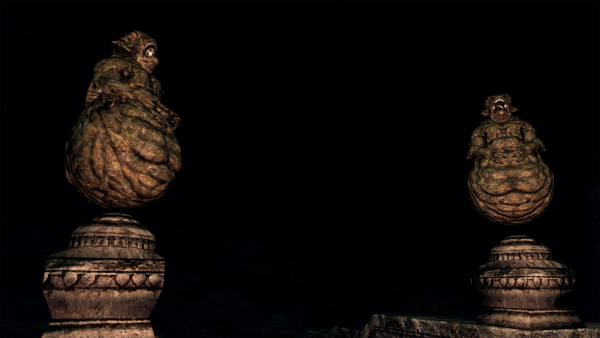
M Stenbæk is a cartoonist, writer, and game maker based in LA. For more studies of game and mind, check out this Tumblr. There is also Twitter.